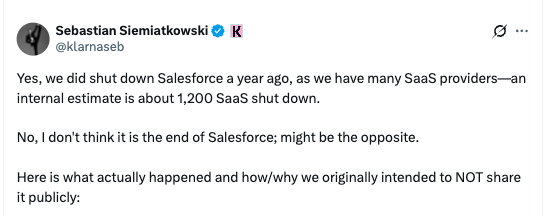
5 Hard Truths About Launching Your SaaS in the AI Era
A reality check for founders who are about to ship AI SaaS
I’ve been helping non-technical founders build and launch their first SaaS products for years. Lately, every conversation starts the same way: “Should my app have AI?” or “I’m worried ChatGPT/Gemini will kill my idea before I even launch.”
If you’re about to launch a SaaS product in 2025, you’re not just competing with other startups anymore. You’re entering a fundamentally different market, thanks to AI. And most founders I talk to are making critical mistakes, because they don’t see the bigger picture.
Here’s what I think you need to know before even developing your MVP.
1. Your “Simple SaaS” Might Be Dead on Arrival
I used to tell founders: “Start simple. Build an MVP. Add features later.” That advice just became dangerous.
According to some industry stats about 78% of organizations now use AI somewhere (either officially, or “secretly” by employees).
Your future customers aren’t looking to add another tool to their stack, they’re looking to eliminate tools.

What this means for your launch: If your SaaS does something that ChatGPT, Claude, or a simple AI workflow can replicate, you’re building a product with a built-in expiration date. Before you launch, ask yourself: “Could a smart customer achieve 80% of my product’s value with a well-crafted prompt and some automation?”
If the answer is yes, you need to go back to the drawing board. The market won’t give you time to figure this out post-launch.
Done are the days when a manager can go to procurement department and request a purchase on a vendor SaaS to extract data from PDF invoices (Which will costs business thousands of dollars annually).
2. “Adding AI Features” Won’t Save You
I see this mistake often: founders who built a traditional SaaS suddenly panic and decide to “add AI” as a feature. They think this will future-proof their product.
It won’t.
Here’s why: adding “AI API Wrapper” to your application give you either razor-thin (< 25%) gross margins or, even worse, higher OPEX. Your customers will reject higher price, just because you added “Chat To AI” feature. They will expect your app to provide new AI feature AND absorb API costs.
And even if you’re fresh to market, if your AI strategy is “let’s integrate ChatGPT,” you’re not building a defensible business, you’re building an expensive middleman.
What this means for your launch: Don’t add AI for AI’s sake. Today startups are AI-native. AI functionality comes as a core visible or hidden solution of their problem.
If you’re going to build AI into your product, it needs to be:
- Trained on proprietary data that makes it uniquely valuable
- Deeply integrated into a workflow that becomes mission-critical
Alternatively, you can build an app that is solving a compliance or regulatory problem that general AI can’t touch (legally).
Otherwise, you’re just burning money on API calls while your customers figure out they can get the same result cheaper elsewhere or go directly to the source like ChatGPT or Gemini.
3. The Subscription Model Is Probably Wrong
The old business model: charge $X per user per month is becoming outdated. That model is dying faster than most realize. For handful of reasons:
Dynamic Operational Costs - because AI vendors often charge per token for their API, predicting customer usage becomes a gamble. Look at Cursor (AI coding platform) trying to backpedal on their unlimited plans. Cursor’s parent company got massive backlash from customers and until this day their VC are paying for users to use their products.
Unpredictable Outcomes - in traditional software 2+2 always equals 4. With AI, there is nuance to this. If your software offer customer resolution AI chatbot, not all customer requests can be resolved or will be resolved with AI. Charging per use becomes harder to justify. Therefore charging per outcome makes more sense. “If AI fails - you don’t pay” approach.
Subscription Fatigue - people are tired of paying for subs, especially on consumer level. $20 here, $16 there, $49 for this, $25 for that. “Why am I paying for this app? I am barely using it!” Consumers and businesses become more aware of leaking money buckets. I had a business client that was paying ~$1500 in various subscription costs for his small business. I helped him reduce that to $250 and optimized his workflow to only have 4 products instead of 12.
So some businesses are moving to outcome-based pricing. Intercom charges $0.99 per successful customer service resolution. EvenUp takes 20-25% of legal settlement values. These aren’t software companies anymore - they’re service companies that happen to use software. This is exactly why the truth about AI wrappers shows that sustainable businesses focus on outcomes, not just technology.
What this means for your launch: Before you set your pricing page to “$29/user/month,” ask yourself: what outcome does your customer actually want to buy? Can you price based on that outcome instead of access to your software?
Alternatively: can you provide them PER USE pricing? For example, If a business customer only upload 3-4 tax documents per quarter - they are not going to pay $35/month, but will happily pay $50 or so per document processed.
If you can make this shift, you’re not competing in the crowded software market anymore. You’re competing in the much larger services market, where customers pay for results, not features.
4. Going Broad Is Now a Death Sentence
Typical gameplay was to encourage founders to build horizontal tools that could serve multiple industries and cast wide net. Not to limit their Total Addressable Market (TAM). We had spur of CRM and Sales pipeline softwares and one-stop-shop. (Clickfunnels, GoHighLevel, Kartra, etc)
That advice will now kill your startup.
The data from Bessemer Venture Partners is clear: vertical AI companies are valued at 11x revenue multiples, while horizontal SaaS companies trade at 5x. The market has decided that specialists win, generalists lose. This is one of the key reasons why I chose B2B over B2C as a solo founder - focused markets are more valuable and easier to dominate.
In simpler terms: if you were to sell or liquidate your SaaS (in the future) - you’re looking at 11X annual revenue vs. 5X offers.
What this means for your launch: If your SaaS tries to serve “small businesses” or “marketing teams” or “remote workers,” you’re already dead. You need to pick a specific vertical - legal, healthcare, construction, financial services - and build something so specialized that a general AI tool could never replicate it.
Yes, this makes your addressable market smaller. But it makes your defensibility infinitely stronger.
Some of my previous clients come back to me for consulting with the following question: “We are paying thousands for HubSpot, but can you recommend a better CRM/ERP specifically our industry? We’ve seen A, B and C on the marketing and want to get your take on those new players”
Businesses are MOVING away from general software.
5. Your Product Roadmap Is Your Biggest Liability
Here’s the most painful truth: your beautiful product roadmap, with all those carefully planned features for V2 and V3, is probably worthless.
What used to take 6-12 months of development advantage can now be replicated in an afternoon. I’ve seen competitors launch near-identical products within weeks of each other, all because the barrier to building software has collapsed. Your offer is now competing with a senior developer + AI tools and a free weekend.
What this means for your launch: Stop thinking about your product as a fortress you’ll build over time. Start thinking about it as a race you need to win quickly. Your competitive advantage isn’t your feature but how quickly you go to market, get feedback and build.
If dev cycles used to take 6-12 months, in that time, your competition has built exact same feature, acquired customers and are onto their feature #4 in their backlog.
Build fast. Ship asap. GET PAYING CUSTOMERS! Get feedback. Add features. Ship. Add features. Ship. Feedback. Repeat.
What I’d Do If I Were Launching Today
If I were building a SaaS product today, here’s exactly what I’d do:
- Pick a hyper-specific vertical where I understand the pain better than anyone else. The market needs to be so specific that you can actually NAME a person who’d pay for your product. Not some “customer avatar ‘Bob accounting who likes fishing’” but ACTUALLY Robert the accountant from ABC Company you’ve met on your trip to Bahamas last April
- Price based on outcomes, not software access. I want to know what my OPEX per each user is and price based on that (per use) OR if my OPEX is tolerably low, but I know a lot of outcome sensitive users - they wont pay per use or monthly. But they will happily pay per sale closed or completed or resolution achieved.
- Build AI-NATIVE app that gets smarter with my specific customers’ data, not just ChatGPT with a pretty interface. I am either personalizing data for user based on their individual needs OR I am integrating “silent AI” to reduce my overhead.
- Plan to be profitable within months, because the window for “build at all costs” has closed. I wouldn’t expect a shebang launch with 100 features that cater to wide range of customers. No. I am building to 5 people I can reach out manually, directly talking to them and building more features as I get the feedback.
- Launch in 30 days or less, because every day you wait is another day for someone else to build what you’re building. The second I get my MVP is outlined, I’d get to building. I want to start marketing on day one and actively communicate with my waitlist on what I am building. This is exactly why your MVP should not take six months - speed to market is everything in today’s environment.
The Bottom Line
The rules of SaaS have fundamentally changed. If you’re about to launch with an old playbook: horizontal product, per-seat pricing, 18-month dev roadmap - you’re “cooked”.
For founders who understand these new rules, the opportunity has never been bigger. Vertical markets are valued higher than ever. Outcome-based pricing unlocks massive value creation. And AI, when done right, can create legitimate MOATs.
The question isn’t whether AI will disrupt your market. The question is whether you’ll build a product that thrives in the disruption or gets crushed by it.
